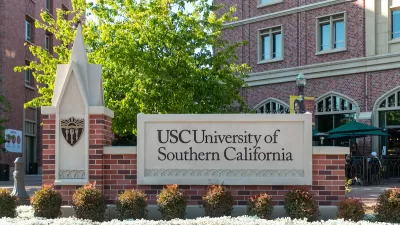The Lincoln Institute of Land Policy spent two years looking at smart growth policies in a number of states to see how well they've achieved their goals. Gregory K. Ingram, President of the Institute, explains the results.
 Attempts to manage development and implement smart growth policies have been through several phases since the early 1970s. But given the looming pressures to reduce greenhouse gas emissions, reduce the use of fossil fuels, and provide affordable housing in the years ahead, a new generation of smart growth policies will soon be upon us.
Attempts to manage development and implement smart growth policies have been through several phases since the early 1970s. But given the looming pressures to reduce greenhouse gas emissions, reduce the use of fossil fuels, and provide affordable housing in the years ahead, a new generation of smart growth policies will soon be upon us.
California, with its climate change legislation, is forging a new approach with special attention to regional planning and to marrying land use and transportation policies. The Obama administration has vowed to pay more attention to cities and metropolitan regions, as the reauthorization of federal transportation spending gets underway. A climate bill in the works includes mandates for states to meet emissions reduction targets, in part by way of land use, green building, and transit.
With this future in mind, it's an appropriate time to ask the question: how have smart growth policies fared thus far? Have they had an impact? Today's policymakers could surely learn from the successes and pitfalls of the recent past.
Two years ago, the Lincoln Institute of Land Policy began to gather 21 leading researchers to analyze the empirical evidence on smart growth, choosing four states – Florida, Maryland, New Jersey and Oregon – that all declared formal statewide smart growth programs through legislation, executive order, and otherwise. Using the 10 Principles of Smart Growth as a reference, this group addressed five important smart growth policy objectives: promoting compact human settlement, protecting undeveloped land, providing a variety of transportation options, maintaining affordable housing, and achieving positive fiscal impacts. Though smart growth policies have been around, in the case of Oregon, for nearly four decades, this kind of comprehensive, objective-based evaluation had never been done.

The Results
What we found was somewhat sobering. No state was able to make gains in all five performance measures. Success was more limited and reflected each state's areas of high priority. Maryland was successful in protecting natural resources through its land preservation programs and state funding for the purchase of farmland conservation easements. New Jersey's affordable housing policies that responded to state supreme court decisions slowed house price escalation and encouraged rental and multifamily housing production. Oregon's commitment to urban growth boundaries helped reduce development on farmland in the Willamette Valley and encouraged commuters to use transit, walk, or bike to work.
But both Oregon and Maryland did poorly in the area of affordable housing, for example, and Florida under-achieved on the objective of promoting compact urban growth.
Perhaps equally telling, performance in some of the four states we selected that had not declared a formal statewide smart growth program -- Colorado, Indiana, Texas, and Virginia – kept pace with the smart growth states in several areas. Colorado, with no statewide smart growth program, outperformed some states with such policies by supporting local government actions to pursue effective land use planning within a regional context.
What does all this tell us? One message is clear: smart growth is doable – this study provides evidence that smart growth outcomes can be achieved – but it's a real challenge. It requires energy and commitment and focus. Even with a lot of inputs, it's hard to move the needle. States need to attend to multiple objectives-land development, housing affordability, transport, and land preservation-all at the same time.
Smart Growth Policies: An Evaluation of Programs and Outcomes recommends that policy makers must articulate the means of achieving smart growth objectives and specify implementation mechanisms rather than just declare objectives. States should use a variety of regulatory controls, market incentives, and institutional policies coordinated at the regional scale, and must take account of interactions among policies and coordination across relevant agencies.
The report also concludes that the successful implementation of smart growth programs requires a credible and persistent commitment from different levels of government. In addition, improvements in measurement and collection of data, particularly related to environmental quality and public finance, are needed to better monitor program performance, and more evidence is needed about the nature of interactions among smart growth policies-particularly those related to land use, transportation, and housing affordability.
The study is an objective-based evaluation using data from the US Census, Census of Governments, Natural Resources Inventory, and other sources. The evaluation concentrates primarily on statewide performance from 1990 to the early 2000s – in part because consistent and comparable data were available. But by looking back, we also can inform the future because many smart growth objectives are precisely the outcomes posited to address today's high energy costs, historic housing market volatility, and increasing pressures to reduce greenhouse gas emissions.
Does smart growth measure up? Not across the board. Going forward, special attention in policy design and implementation – as well as committed political leadership – will be needed for the new generation of smart growth to have a chance at achieving important policy goals.
Gregory K. Ingram, president of the Lincoln Institute of Land Policy, is co-editor of Smart Growth Policies: An Evaluation of Programs and Outcomes. To download the full report click here.

Planetizen Federal Action Tracker
A weekly monitor of how Trump’s orders and actions are impacting planners and planning in America.

Congressman Proposes Bill to Rename DC Metro “Trump Train”
The Make Autorail Great Again Act would withhold federal funding to the system until the Washington Metropolitan Area Transit Authority (WMATA), rebrands as the Washington Metropolitan Authority for Greater Access (WMAGA).

The Simple Legislative Tool Transforming Vacant Downtowns
In California, Michigan and Georgia, an easy win is bringing dollars — and delight — back to city centers.

The States Losing Rural Delivery Rooms at an Alarming Pace
In some states, as few as 9% of rural hospitals still deliver babies. As a result, rising pre-term births, no adequate pre-term care and harrowing close calls are a growing reality.

The Small South Asian Republic Going all in on EVs
Thanks to one simple policy change less than five years ago, 65% of new cars in this Himalayan country are now electric.

DC Backpedals on Bike Lane Protection, Swaps Barriers for Paint
Citing aesthetic concerns, the city is removing the concrete barriers and flexposts that once separated Arizona Avenue cyclists from motor vehicles.
Urban Design for Planners 1: Software Tools
This six-course series explores essential urban design concepts using open source software and equips planners with the tools they need to participate fully in the urban design process.
Planning for Universal Design
Learn the tools for implementing Universal Design in planning regulations.
Smith Gee Studio
City of Charlotte
City of Camden Redevelopment Agency
City of Astoria
Transportation Research & Education Center (TREC) at Portland State University
US High Speed Rail Association
City of Camden Redevelopment Agency
Municipality of Princeton (NJ)





























